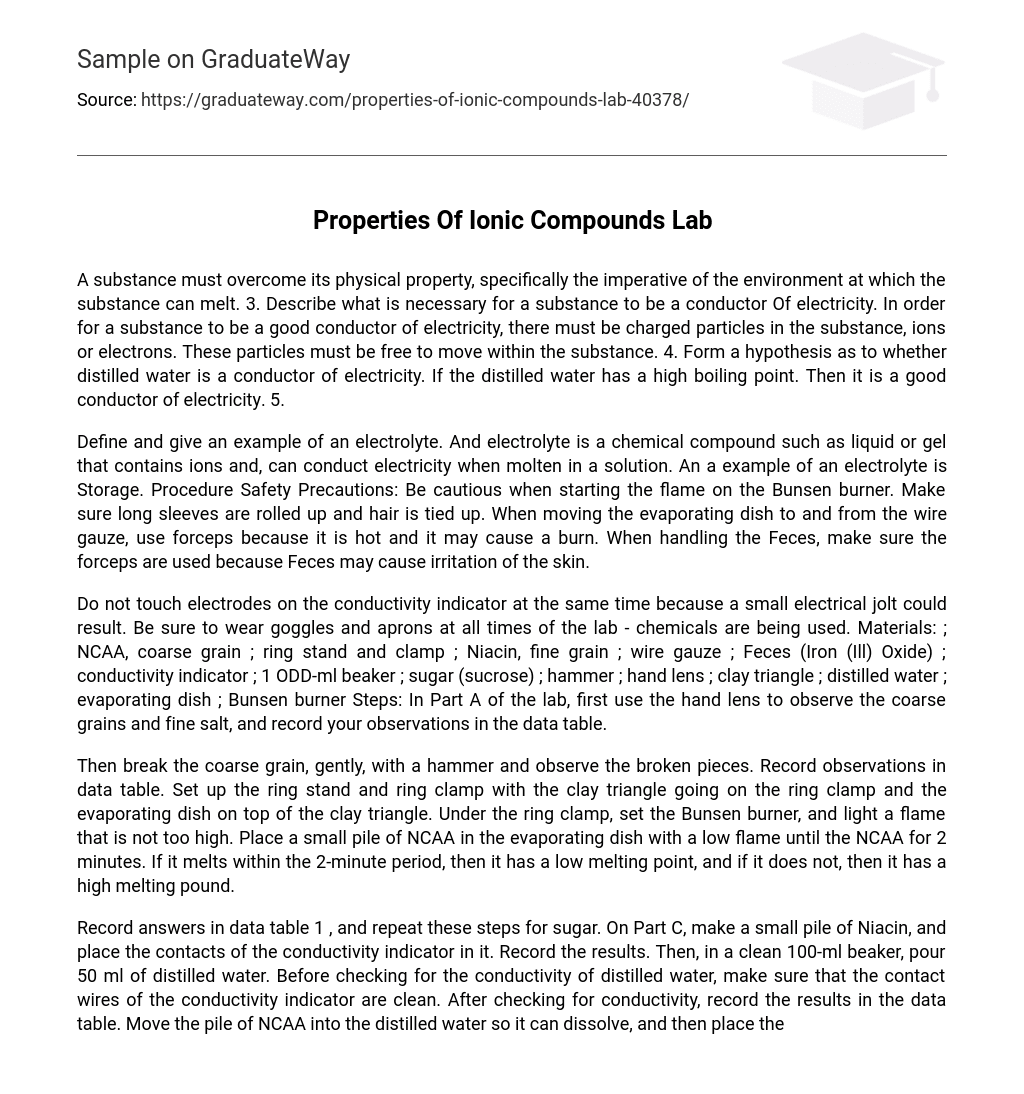Describe what is necessary for a substance to be a conductor Of electricity. In order for a substance to be a good conductor of electricity, there must be charged particles in the substance, ions or electrons. These particles must be free to move within the substance.
Form a hypothesis as to whether distilled water is a conductor of electricity. If the distilled water has a high boiling point. Then it is a good conductor of electricity.
Define and give an example of an electrolyte. And electrolyte is a chemical compound such as liquid or gel that contains ions and, can conduct electricity when molten in a solution. An a example of an electrolyte is Storage.
Procedure Safety Precautions: Be cautious when starting the flame on the Bunsen burner. Make sure long sleeves are rolled up and hair is tied up. When moving the evaporating dish to and from the wire gauze, use forceps because it is hot and it may cause a burn. When handling the Feces, make sure the forceps are used because Feces may cause irritation of the skin.
Do not touch electrodes on the conductivity indicator at the same time because a small electrical jolt could result. Be sure to wear goggles and aprons at all times of the lab – chemicals are being used. Materials: ; NCAA, coarse grain ; ring stand and clamp ; Niacin, fine grain ; wire gauze ; Feces (Iron (Ill) Oxide) ; conductivity indicator ; 1 ODD-ml beaker ; sugar (sucrose) ; hammer ; hand lens ; clay triangle ; distilled water ; evaporating dish ; Bunsen burner Steps: In Part A of the lab, first use the hand lens to observe the coarse grains and fine salt, and record your observations in the data table.
Then break the coarse grain, gently, with a hammer and observe the broken pieces. Record observations in data table. Set up the ring stand and ring clamp with the clay triangle going on the ring clamp and the evaporating dish on top of the clay triangle. Under the ring clamp, set the Bunsen burner, and light a flame that is not too high. Place a small pile of NCAA in the evaporating dish with a low flame until the NCAA for 2 minutes. If it melts within the 2-minute period, then it has a low melting point, and if it does not, then it has a high melting pound.
On Part C, make a small pile of Niacin, and place the contacts of the conductivity indicator in it. Record the results. Then, in a clean 100-ml beaker, pour 50 ml of distilled water. Before checking for the conductivity of distilled water, make sure that the contact wires of the conductivity indicator are clean. After checking for conductivity, record the results in the data table. Move the pile of NCAA into the distilled water so it can dissolve, and then place the conductivity indicator in the new solution.
Record results. Now, repeat these steps for sugar. Set up the ring stand, with clay triangle being on top of the ring clamp and the evaporating dish being on top of the clay triangle. Place the Bunsen burner under the ring clamp with a low flame. Lace approximately 1 gram Of Feces in a dry, clean evaporating dish. Place the conductivity indicator on the solid form of Feces before heating it up. Set the evaporating dish on top of the clay triangle and heat the Feces until it melts.
Immediately turn off the Bunsen burner, and place the clean contact wire of the conductivity indicator into the melted Feces. Record observations, and remove the conductivity indicator, and then clean the contact wires. Be careful not to touch the evaporating dish before letting it cool for ten minutes because it may burn. When done with the lab, ask the teacher for directions for the disposal of he Feces. Make sure that burner and clamp are cooled before putting it away.
Clean the lab area, and carefully put back all equipment in its proper place. Data: Part A: Crystal Lattice Observations about the coarse and fine Niacin Coarse: rocky, flat sides, white, almost transparent Fine: crystallites, small, powdering white Observations about the pieces of NCAA after breaking the coarse salt White, powder like Part B: Melting Point Observations about the melting point of NCAA (high or low melting point) High melting point Observations about the melting point Of sugar (high or low melting point) Low.
Part C: Conductivity Test Substance Conductivity Indicator (Record light as off, dull, bright, or blinking) Conductor Rating (good, poor, or none) solid Ana Off None Distilled water A very faint sound Poor NCAA dissolved in distilled water Loud sound Good Sugar dissolved in distilled water Faint sound Solid Feces Very faint sound Very poor Molten Feces Immediate sound Questions:
- From the results of Part A, and using words like soft, ductile, malleable, brittle, hard, or pliable, how would you describe sodium chloride?
- Sodium chloride and Iron (Ill) Chloride are typical ionic compounds, while sugar presents a typical nonionic compound.





